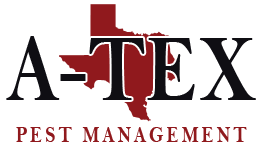Western Drywood Termites (Incisitermes minor) are a destructive species of termites that pose a significant threat to wooden structures in the western United States. Unlike subterranean termites, which thrive in moist soil environments, drywood termites can live and feed directly on dry wood, making them particularly challenging pests to control. Understanding the basics of Western Drywood Termites is crucial for homeowners and pest control professionals alike to effectively manage and prevent infestations. With this in mind, we at A-Tex Pest Management would like to discuss the basics of western drywood termites.
Termite Identification & Biology
Western Drywood Termites are small insects, typically ranging from 3/8 to 1/2 inch in length, with a light brown to dark brown coloration. Their bodies are segmented, and they have straight antennae. Unlike subterranean termites, Western Drywood Termites do not require contact with soil for survival. They create colonies directly within the wood they infest, making their presence harder to detect. These termites reproduce through swarming. Winged reproductive individuals, known as alates, emerge from mature colonies and fly in search of new nesting sites. Once they find a suitable location, they shed their wings, pair up, and start a new colony. The queen lays eggs, and as the colony grows, the termites create intricate tunnel systems within the wood for protection.
Termite Feeding & Damage
Western Drywood Termites feed on the cellulose present in wood, extracting nutrients to sustain their colonies. Unlike subterranean termites that need constant contact with soil to maintain moisture levels, drywood termites can survive on the limited moisture content within the wood they infest. This ability allows them to attack a variety of wooden structures, including furniture, framing, and even decorative wooden items. The damage caused by Western Drywood Termites can be extensive and may go unnoticed for long periods. Infestations are often discovered when homeowners find piles of tiny fecal pellets, resembling coffee grounds, near infested wood. The pellets are a distinctive sign of drywood termite activity.
Termite Prevention & Control
Preventing and controlling Western Drywood Termite infestations requires a combination of proactive measures and professional intervention. Homeowners can take steps to minimize the risk of infestation by ensuring proper ventilation, promptly repairing leaks, and sealing any cracks or crevices in wooden structures. Professional pest control services are often necessary to effectively address established infestations. Treatment options include fumigation, which involves sealing the structure and introducing a gas that permeates the wood, reaching termites hidden deep within. Additionally, localized treatments, such as spot treatments and injection of termiticides directly into infested wood, may be employed.
Termite Pest Inspections, Treatment, Control, Removal & More in Austin, Round Rock, Leander, Pflugerville & Cedar Park Texas
Western Drywood Termites pose a serious threat to wooden structures in the western United States. Their ability to thrive in dry conditions and infest various wood sources makes them a challenging pest to manage. Homeowners should be vigilant for signs of infestation, such as fecal pellets or discarded wings, and seek professional assistance for thorough inspections and effective treatments. Implementing preventive measures and maintaining a proactive approach to termite control is essential in protecting homes and structures from the destructive impact of Western Drywood Termites. If you suspect termites in your Austin, TX home or business, contact A-Tex Pest Management.










